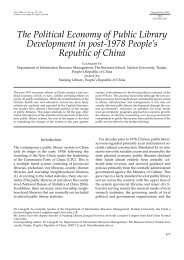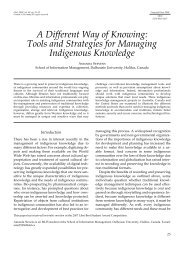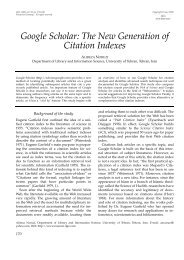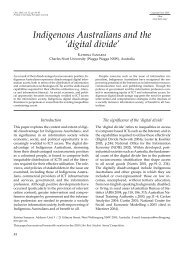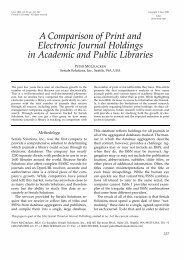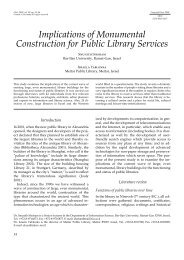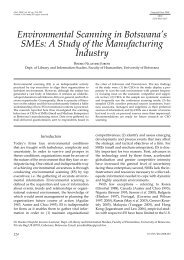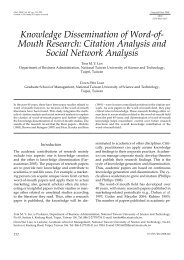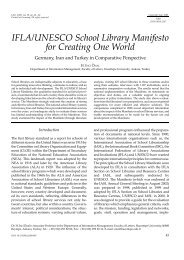Libraries as Scientific, Educational and Cultural Institutions in ... - Libri
Libraries as Scientific, Educational and Cultural Institutions in ... - Libri
Libraries as Scientific, Educational and Cultural Institutions in ... - Libri
You also want an ePaper? Increase the reach of your titles
YUMPU automatically turns print PDFs into web optimized ePapers that Google loves.
<strong>Libri</strong>, 2006, vol. 56, pp. 252–263<br />
Pr<strong>in</strong>ted <strong>in</strong> Germany · All rights reserved<br />
252<br />
<strong>Libraries</strong> <strong>as</strong> <strong>Scientific</strong>, <strong>Educational</strong> <strong>and</strong><br />
<strong>Cultural</strong> <strong>Institutions</strong> <strong>in</strong> the Ottoman<br />
Empire (XIV th<br />
– XVII th<br />
Centuries)<br />
FATIH RUKANCI AND HAKAN ANAMERIÇ<br />
Department of Information <strong>and</strong> Records Management, Faculty of Letters,<br />
University of Ankara, Turkey<br />
<strong>Libraries</strong> are social <strong>in</strong>stitutions that have existed <strong>in</strong> Turkish<br />
cultural <strong>and</strong> scientific life for 800 years. Dur<strong>in</strong>g this long<br />
period, they took an active part <strong>in</strong> preserv<strong>in</strong>g, reproduc<strong>in</strong>g<br />
the sources of knowledge, <strong>and</strong> mak<strong>in</strong>g them available to different<br />
levels of the society. By analys<strong>in</strong>g the functions <strong>and</strong><br />
characteristics of the libraries <strong>in</strong> the Ottoman Empire between<br />
the XIV th<br />
<strong>and</strong> XVII th<br />
centuries, one can see that with-<br />
Introduction<br />
Initially founded <strong>in</strong> Ancient Sumer <strong>and</strong> Egypt, libraries<br />
pursued their development <strong>in</strong> other great<br />
civilisations such <strong>as</strong> Babylon, Assyria, the Hittite<br />
Empire, Rome <strong>and</strong> Byzantium, <strong>and</strong> diffused the<br />
tradition of libraries <strong>and</strong> librarians to other civilisations.<br />
<strong>Libraries</strong> have a long background <strong>as</strong> supportive<br />
<strong>in</strong>stitutions for science <strong>and</strong> culture s<strong>in</strong>ce<br />
their appearance around 3000 B.C.<br />
<strong>Libraries</strong> <strong>in</strong> the Ottoman Empire have been<br />
characterized <strong>as</strong> auxiliary <strong>in</strong>stitutions support<strong>in</strong>g<br />
scientific life <strong>and</strong> help<strong>in</strong>g education, <strong>and</strong> therefore<br />
they survived until the collapse of the Empire.<br />
The aim of this study is to elaborate the historical<br />
development of libraries <strong>in</strong> regard to the importance<br />
given to them with<strong>in</strong> the period of the<br />
XIV th<br />
–XVII th<br />
centuries from the establishment of<br />
the Ottoman Empire to its decl<strong>in</strong>e. Furthermore,<br />
almost all libraries established <strong>as</strong> foundation [1]<br />
<strong>in</strong>stitutions <strong>and</strong> managed with<strong>in</strong> the Ottoman Empire<br />
will be exam<strong>in</strong>ed <strong>in</strong> terms of their architec-<br />
Copyright © Saur 2006<br />
______________________________________________<br />
<strong>Libri</strong><br />
ISSN 0024-2667<br />
out any doubt the book <strong>and</strong> the library tradition played important<br />
roles <strong>in</strong> the scientific, social <strong>and</strong> cultural formation<br />
of society <strong>in</strong> a nation nearly 600 years old. The establishment<br />
of important libraries, library types, their collections, their<br />
employees <strong>and</strong> their goals <strong>and</strong> functions show that libraries<br />
held an important place <strong>in</strong> the social, scientific <strong>and</strong> cultural<br />
life of the Ottoman Empire.<br />
tural characteristics, employees, services, collections<br />
<strong>and</strong> their relationships with other scientific<br />
<strong>and</strong> educational <strong>in</strong>stitutions. All of these historical<br />
clarifications will be helpful to underst<strong>and</strong> the<br />
status of the libraries <strong>in</strong> the Ottoman Empire.<br />
Development of libraries <strong>in</strong> Anatolia dur<strong>in</strong>g<br />
the XIII th –XIV th centuries<br />
The librarianship tradition <strong>in</strong> the Turkish States<br />
h<strong>as</strong> been mostly <strong>in</strong>fluenced by the Medieval Islamic<br />
civilisation. Dur<strong>in</strong>g its development <strong>in</strong> the<br />
period of the Four Caliphates (632–661), the Arabic-Islamic<br />
Empire met the Turks for the first time<br />
dur<strong>in</strong>g the Nihavend War <strong>in</strong> 642. Follow<strong>in</strong>g this<br />
contact, mutual cultural <strong>in</strong>fluence began. The<br />
Arabic-Islamic Empire exp<strong>and</strong>ed its borders <strong>and</strong><br />
completed its development dur<strong>in</strong>g the Umayyad<br />
(661–750) <strong>and</strong> Abb<strong>as</strong>id (750–1258) er<strong>as</strong>. Dur<strong>in</strong>g<br />
this period, Islamic civilisation reached its summit<br />
<strong>in</strong> science, art, philosophy <strong>and</strong> literature.<br />
Places of worship <strong>and</strong> educational <strong>in</strong>stitutions<br />
Fatih Rukancı, Dr., Department of Information <strong>and</strong> Records Management, Faculty of Letters, University of Ankara. E-mail:<br />
frukanci@gmail.com<br />
Hakan Anameriç, Research Asst. Department of Information <strong>and</strong> Records Management, Faculty of Letters, University of<br />
Ankara. E-mail: hakananameric@gmail.com
<strong>Libraries</strong> <strong>as</strong> <strong>Scientific</strong>, <strong>Educational</strong> <strong>and</strong> <strong>Cultural</strong> <strong>Institutions</strong> <strong>in</strong> the Ottoman Empire (XIVth – XVIIth Centuries)<br />
such <strong>as</strong> mosques, madr<strong>as</strong>a <strong>and</strong> libraries, together<br />
with orig<strong>in</strong>al <strong>and</strong> translated works, supported<br />
this advance (M. S, emsedd<strong>in</strong> 2005).<br />
Sciences <strong>in</strong> the educational <strong>and</strong> scientific life of<br />
Islamic civilisation comprised two ma<strong>in</strong> groups:<br />
first, the narrative sciences which were used for<br />
the transfer of the fundamental teach<strong>in</strong>gs of Islam;<br />
second, the rational sciences which <strong>in</strong>cluded<br />
the pure <strong>and</strong> applied sciences. <strong>Libraries</strong> were<br />
considered <strong>in</strong> Islamic civilisations <strong>as</strong> “<strong>in</strong>stitutions<br />
where foreign scientific studies are found” (Makdisi<br />
2004). <strong>Libraries</strong> were educational <strong>in</strong>stitutions<br />
teach<strong>in</strong>g traditional sciences <strong>as</strong> well <strong>in</strong>novative<br />
sciences (Demir 2001).<br />
Noun phr<strong>as</strong>es were used <strong>in</strong> Islamic civilisation<br />
to def<strong>in</strong>e libraries. Three of these words def<strong>in</strong>ed<br />
the place: beyt (house, room), hizâne (cell, small<br />
room, warehouse) <strong>and</strong> dâr (house). The other<br />
words used def<strong>in</strong>ed the content: hikme(t) (wisdom),<br />
ilim (science) <strong>and</strong> kütüp (books). Various<br />
noun phr<strong>as</strong>es def<strong>in</strong><strong>in</strong>g a library can thus be identified:<br />
beytü’l-hikme, hizânetü’l-hikme, dârü’l-hikme,<br />
dârü’l-ilim, dârü’l-kütüb, hizanetü’l-kütüb, beytü’lkütüb,<br />
beytü’l-ilim <strong>and</strong> el-hizanetü’l-ilmiyye (Makdisi<br />
2004; Eche 1963; McClellan <strong>and</strong> Dorn 2005).<br />
Between the IX th <strong>and</strong> XIII th centuries, the Abb<strong>as</strong>ids<br />
(750–1258) <strong>and</strong> Great Seljukians (1040–1157) built<br />
libraries under the names of beytü’l-hikme, hizânetü’l-kütüb,<br />
hizânetü’l-hikme, dârü’l-hikme, dârü’l-ilim<br />
<strong>and</strong> dârü’l-kütüb (Bloom 2003). In big<br />
cities these libraries were set up <strong>in</strong> establishments<br />
with educational <strong>as</strong> well <strong>as</strong> religious roles, such<br />
<strong>as</strong> mosque, m<strong>as</strong>jid, ribât, hankâh or madr<strong>as</strong>a, <strong>and</strong><br />
also <strong>in</strong> private houses. These libraries had books<br />
about all k<strong>in</strong>ds of subject. Those who founded<br />
these libraries offered books to readers without<br />
any limitations. Needy users were even provided<br />
free meals, accommodation <strong>and</strong> pocket money. In<br />
addition to offer<strong>in</strong>g the ma<strong>in</strong> library services,<br />
they also copied books <strong>and</strong> organized discussions<br />
<strong>and</strong> debates.<br />
The librarianship <strong>and</strong> library traditions p<strong>as</strong>sed<br />
to the Ottomans through the Karakhanids (840–<br />
1042), Great Seljukians, Anatolian Seljukians<br />
(1077–1308) <strong>and</strong> I .<br />
lhanlı States (1256–1336) demonstrated<br />
important development especially <strong>in</strong><br />
XV th<br />
century. With their social, cultural, political<br />
<strong>and</strong> educational system, these sovereign states of<br />
Anatolia played important roles with<strong>in</strong> the scientific<br />
life <strong>and</strong> educational system of the Ottomans.<br />
In Anatolia dur<strong>in</strong>g the XIII th<br />
century, especially <strong>in</strong><br />
Konya, the capital of the Anatolian Seljukians<br />
State, many libraries with<strong>in</strong> the madr<strong>as</strong><strong>as</strong> were<br />
built. The first one <strong>in</strong> Konya <strong>in</strong> this period is the<br />
library of the S, emsedd<strong>in</strong> Altunaba madr<strong>as</strong>a, built<br />
dur<strong>in</strong>g 1201–1202. Private libraries with<strong>in</strong> palaces,<br />
mansions <strong>and</strong> houses of Anatolian Seljukian<br />
rulers, viziers, emirs, pr<strong>in</strong>ces <strong>and</strong> scientists were<br />
followed by the libraries established <strong>in</strong> madr<strong>as</strong><strong>as</strong>,<br />
mosques <strong>and</strong> imarethanes for scientists, students<br />
<strong>and</strong> people (Cunbur 1966).<br />
At various periods of the Ottoman Empire, the<br />
book collect<strong>in</strong>g tradition <strong>in</strong> religious, scientific,<br />
<strong>and</strong> literature subjects <strong>and</strong> the library tradi-<br />
tion w<strong>as</strong> cont<strong>in</strong>ued. Start<strong>in</strong>g from the beg<strong>in</strong>n<strong>in</strong>g<br />
of the Ottoman Empire, the sultans, gr<strong>and</strong> viziers,<br />
sultan<strong>as</strong>, pr<strong>in</strong>ces, sheikhulislams <strong>and</strong> other<br />
government officials established libraries <strong>in</strong>side<br />
educational <strong>in</strong>stitutions, place of worships, complexes<br />
of build<strong>in</strong>gs (külliye) adjacent to mosques<br />
or <strong>in</strong> <strong>in</strong>dependent build<strong>in</strong>gs. Nearly all of the<br />
libraries were established <strong>as</strong> foundations, <strong>and</strong> <strong>in</strong>formation<br />
about the re<strong>as</strong>on for their establishment,<br />
places, management, <strong>in</strong>come <strong>and</strong> expenses,<br />
personnel, personnel characteristics, numbers of<br />
items <strong>and</strong> collection were present <strong>in</strong> their charter<br />
of foundation (vakfiye).<br />
It is possible to sort libraries built <strong>in</strong> the Ottoman<br />
State from its beg<strong>in</strong>n<strong>in</strong>g till XIX th century <strong>in</strong>to<br />
different categories. This categorization is generally<br />
made accord<strong>in</strong>g to build<strong>in</strong>g characteristics<br />
<strong>and</strong> location. Almost all of Ottoman period libraries<br />
were established <strong>as</strong> charitable foundations<br />
<strong>and</strong> were adm<strong>in</strong>istrated <strong>as</strong> foundation <strong>in</strong>stitutions.<br />
Sultans, gr<strong>and</strong> viziers, viziers, sheikh ul-<br />
islams, sultan<strong>as</strong>, pr<strong>in</strong>ces, scientists, benevolent<br />
government officials <strong>and</strong> diverse religious priests,<br />
established these foundations.<br />
<strong>Libraries</strong> that have been established accord<strong>in</strong>g<br />
to their build<strong>in</strong>g characteristics <strong>and</strong> their locations<br />
may be cl<strong>as</strong>sified <strong>as</strong>:<br />
• <strong>Libraries</strong> founded <strong>in</strong> or neighbour<strong>in</strong>g mosques, lecture<br />
halls <strong>and</strong> schools;<br />
• Private libraries founded <strong>in</strong> palaces belong<strong>in</strong>g to<br />
sultans <strong>and</strong> sultan<strong>as</strong>;<br />
• <strong>Libraries</strong> founded <strong>in</strong> or neighbour<strong>in</strong>g convents, tombs,<br />
mon<strong>as</strong>teries of dervishes, convents of Mevlevi dervishes;<br />
• Independent libraries possess<strong>in</strong>g their own build<strong>in</strong>gs;<br />
• Private libraries <strong>in</strong> houses, mansions, rooms, etc. (Soysal,<br />
1998; Gökman 1939; Erünsal 1999; Emsen 1960).<br />
253
Fatih Rukancı <strong>and</strong> Hakan Anameriç<br />
Beside these libraries, it is supposed that public<br />
service foundations like halt<strong>in</strong>g places (<strong>in</strong>n, caravanserai)<br />
<strong>and</strong> health establishments (hospital,<br />
lunatic or soul <strong>as</strong>ylums), possessed libraries for<br />
public needs (Soysal 1998).<br />
To exam<strong>in</strong>e the formation of the Ottoman foundation<br />
libraries <strong>and</strong> Turkish librarianship it will<br />
be helpful <strong>and</strong> more realistic to focus on the period<br />
between XIV th <strong>and</strong> XVII th centuries.<br />
254<br />
<strong>Libraries</strong> <strong>in</strong> the XIV th<br />
century<br />
Ottoman Empire<br />
The XIV th century is the beg<strong>in</strong>n<strong>in</strong>g<br />
of the establishment of the Ottoman<br />
Empire. <strong>Libraries</strong> <strong>in</strong> the Ottoman<br />
Empire were established<br />
with<strong>in</strong> madr<strong>as</strong><strong>as</strong> which were education<br />
<strong>and</strong> learn<strong>in</strong>g centres. The<br />
first madr<strong>as</strong>a, I . znik (Orhaniye),<br />
w<strong>as</strong> founded by the Ottomans <strong>in</strong><br />
1331 dur<strong>in</strong>g the period of Orhan<br />
Bey (1326–1360). However, there<br />
is no clear evidence whether there<br />
w<strong>as</strong> a library founded <strong>in</strong> this madr<strong>as</strong>a.<br />
The period of Murat I is considered<br />
the first milestone <strong>in</strong> sultans’<br />
private libraries. <strong>Libraries</strong> built<br />
dur<strong>in</strong>g this period were, like<br />
those from Orhan Bey’s period,<br />
conta<strong>in</strong>ed with<strong>in</strong> madr<strong>as</strong><strong>as</strong> <strong>and</strong><br />
külliye <strong>as</strong> rooms or cl<strong>as</strong>srooms.<br />
We know from a possession register<br />
written with gold <strong>in</strong>k that Murat<br />
I had a private library <strong>and</strong><br />
made copies to improve his collection<br />
(Ünver 1952).<br />
Dur<strong>in</strong>g the reign of Yıldırım Bayezid (1389–<br />
1402), the return of scientists f<strong>in</strong>ish<strong>in</strong>g their studies<br />
<strong>in</strong> important scientific <strong>and</strong> cultural cen-<br />
tres such <strong>as</strong> Cairo, Baghdad, Jerusalem <strong>and</strong><br />
Dam<strong>as</strong>cus, <strong>and</strong> the additional need for new of-<br />
ficials to govern the exp<strong>and</strong>ed territories <strong>in</strong><br />
Europe <strong>and</strong> Anatolia contributed to the crea-<br />
tion of new madr<strong>as</strong><strong>as</strong> <strong>in</strong> I . znik <strong>and</strong> especially <strong>in</strong><br />
the capital Bursa. Among these I . nebey <strong>and</strong> Yıldırım<br />
madr<strong>as</strong><strong>as</strong> possessed libraries. The existence<br />
of these libraries w<strong>as</strong> revealed by the presence<br />
of a librarian <strong>in</strong> I . nebey madr<strong>as</strong>a <strong>and</strong> a bookb<strong>in</strong>der<br />
<strong>in</strong> Yıldırım madr<strong>as</strong>a (Ünver 1970; Ünver<br />
I . nebey Madr<strong>as</strong>a Library is the first madr<strong>as</strong>a<br />
library <strong>in</strong> the Ottoman Empire. The<br />
library w<strong>as</strong> built <strong>in</strong> the period of Yıldırım<br />
Bayezid (1389–1402)<br />
1952). Accord<strong>in</strong>g to this <strong>in</strong>formation, the library<br />
with<strong>in</strong> the I . nebey madr<strong>as</strong>a may be considered to<br />
be the first madr<strong>as</strong>a library <strong>in</strong> the Ottoman Empire.<br />
<strong>Libraries</strong> <strong>in</strong> the XV th<br />
century<br />
Ottoman Empire<br />
Internal disorders <strong>as</strong> well <strong>as</strong> struggles for the<br />
throne concluded <strong>in</strong> 1413 when Mehmet I <strong>as</strong>cended<br />
the throne, <strong>and</strong> the Ottoman Empire cont<strong>in</strong>ued<br />
to build Anatolian-Turkish unity. The<br />
reign of Mehmet I (1413–1421) saw a series of<br />
wars <strong>and</strong> improvements on the<br />
political <strong>as</strong> well <strong>as</strong> the military<br />
side of the state. Because of this,<br />
no priority w<strong>as</strong> <strong>as</strong>signed to education<br />
<strong>and</strong> cultural matters. However<br />
it is known that Mehmet I<br />
had a private library. Some of the<br />
books from his collection <strong>in</strong>cluded:<br />
Çapverdi Tefsiri – Fatih<br />
Library, Mizanü’l-itidâl fi Nak-<br />
dü’r-rical 1 st<br />
2 nd<br />
<strong>and</strong> 3 rd<br />
book –<br />
Sa<strong>in</strong>t Sophie Library, Kitab-ı Diyoskoridos<br />
(Kitabu’l-H<strong>as</strong>,ayis,) –<br />
Ahmet III Library (Ayverdi 1966;<br />
Erünsal 1991). In addition to religious<br />
titles, Mehmet I’s library<br />
also <strong>in</strong>cluded scientific books.<br />
Dur<strong>in</strong>g the reign of Murat II<br />
(1421–1451), <strong>as</strong> the state rega<strong>in</strong>ed<br />
its power <strong>and</strong> retook its lost<br />
l<strong>and</strong>s, scientific <strong>and</strong> educational<br />
activities <strong>in</strong>cre<strong>as</strong>ed. Dur<strong>in</strong>g this<br />
period libraries began to appear<br />
<strong>in</strong> places of worship such <strong>as</strong><br />
mosques <strong>and</strong> m<strong>as</strong>jids. [2]<br />
The deed of trust of Murat II’s foundation<br />
shows that books related to Moslem jurisprudence<br />
(fıkıh), religious tradition of the Prophet<br />
(hâdis), <strong>in</strong>terpretation (tefsir) <strong>and</strong> other<br />
sciences were donated to the library for the use of<br />
<strong>in</strong>structors <strong>and</strong> students. The 71 donated books<br />
were written <strong>in</strong> Arabic, presumably because the<br />
library w<strong>as</strong> built for the clerics. Murat II donated<br />
some of his private collection to the <strong>in</strong>stitutions<br />
he founded: Dârü’l-hadis madr<strong>as</strong>a, Üç S, erefeli<br />
mosque <strong>and</strong> Muradiye madr<strong>as</strong>a libraries. On the<br />
titles he donated appears the seal “Vakf-ı Sultan<br />
Murad Han” (Ünver 1972; Ünver 1952).
<strong>Libraries</strong> <strong>as</strong> <strong>Scientific</strong>, <strong>Educational</strong> <strong>and</strong> <strong>Cultural</strong> <strong>Institutions</strong> <strong>in</strong> the Ottoman Empire (XIVth – XVIIth Centuries)<br />
The era of Fatih Sultan Mehmet the Conqueror<br />
(1451–1481) is a turn<strong>in</strong>g po<strong>in</strong>t for libraries <strong>and</strong><br />
Turkish librarianship. Dur<strong>in</strong>g this period, the Ottoman<br />
Empire h<strong>as</strong> completed its constitution <strong>and</strong><br />
acquired its imperial identity. Parallel to the settlement<br />
of military, economic <strong>and</strong> political systems,<br />
developments <strong>in</strong> the arts <strong>and</strong> cultural fields<br />
accelerated. The <strong>in</strong>cre<strong>as</strong>e of activities <strong>in</strong> education,<br />
science <strong>and</strong> culture dur<strong>in</strong>g the reign of Fatih<br />
Sultan Mehmet is owed to his special concern<br />
with these matters. Beh<strong>in</strong>d this is the <strong>in</strong>fluence of<br />
Fatih’s <strong>in</strong>structors, Mullah Gürâni <strong>and</strong> Mullah<br />
Hüsrev. These circumstances <strong>in</strong>cre<strong>as</strong>ed the <strong>in</strong>terest<br />
of Fatih <strong>in</strong> science <strong>and</strong> books,<br />
result<strong>in</strong>g <strong>in</strong> his wish to transform<br />
the newly conquered I . stanbul not<br />
only <strong>as</strong> the new capital of the empire<br />
but also <strong>in</strong>to an important<br />
cultural centre of the Islamic<br />
world. With<strong>in</strong> the build<strong>in</strong>g improvements<br />
realized by Fatih Sultan<br />
Mehmet <strong>in</strong> I . stanbul külliye,<br />
madr<strong>as</strong><strong>as</strong> <strong>and</strong> mosques are <strong>in</strong><br />
forefront. This illustrates the special<br />
importance accorded by Fatih<br />
Sultan Mehmet to education <strong>and</strong><br />
scientific topics.<br />
We can cl<strong>as</strong>sify libraries built<br />
dur<strong>in</strong>g the reign of Fatih <strong>in</strong> two<br />
categories. First the private libraries<br />
built <strong>in</strong> palaces <strong>in</strong> different cit-<br />
<strong>in</strong>g generally textbooks <strong>in</strong> the Arabic language<br />
<strong>and</strong> other miscellaneous themes for the use of <strong>in</strong>structors<br />
<strong>and</strong> students. In 1453 Sa<strong>in</strong>t Sophie <strong>and</strong><br />
Pantakrator (Zeyrek) mon<strong>as</strong>teries were transformed<br />
<strong>in</strong>to madr<strong>as</strong>a <strong>and</strong> were important madr<strong>as</strong><strong>as</strong><br />
until the foundation of the Sahn-ı Seman<br />
madr<strong>as</strong><strong>as</strong>. It is not know if these two madr<strong>as</strong><strong>as</strong><br />
had a library. Their construction started <strong>in</strong> 1463<br />
<strong>and</strong> w<strong>as</strong> completed <strong>in</strong> 1470; the Fatih Külliye became<br />
the most important educational <strong>and</strong> scientific<br />
centre. Sahn-ı Seman <strong>and</strong> Tetimme Madr<strong>as</strong><strong>as</strong><br />
built <strong>in</strong>side this Külliye also had their own libraries.<br />
Once the construction of Fatih Külliye w<strong>as</strong><br />
completed, the Sahn-ı Seman <strong>and</strong><br />
Tetimme madr<strong>as</strong><strong>as</strong> built <strong>in</strong>side<br />
the külliye opened their libraries.<br />
The establishment of these new<br />
madr<strong>as</strong><strong>as</strong> meant the end of Sa<strong>in</strong>t<br />
Sophie <strong>and</strong> Pantokrator Madr<strong>as</strong><strong>as</strong>.<br />
With their cessation, their respective<br />
collections were merged<br />
<strong>and</strong> transferred to the new library<br />
<strong>in</strong>side Fatih Külliye (Adıvar 1943;<br />
Cunbur 1962, 1969; Çoruh 1972;<br />
Emsen 1960; Erünsal 1991, 1999;<br />
Ünver 1952).<br />
For the Ottoman Empire, Fatih<br />
Sultan Mehmet’s era w<strong>as</strong> a period<br />
of development <strong>in</strong> many fields,<br />
<strong>and</strong> some scholars consider that<br />
the identity of the Empire w<strong>as</strong><br />
ies dur<strong>in</strong>g his pr<strong>in</strong>ceship <strong>and</strong> Sultana.<br />
The others are libraries built<br />
<strong>in</strong> mosques <strong>and</strong> madr<strong>as</strong><strong>as</strong> for the<br />
use of <strong>in</strong>structors, students <strong>and</strong> scientists. The exact<br />
date of the first private library established by<br />
Fatih is not known. The date of establishment for<br />
this library is presumed to be dur<strong>in</strong>g his governorship<br />
<strong>in</strong> Manisa Saruhan, <strong>in</strong> his pr<strong>in</strong>ceship palace<br />
<strong>in</strong> the mid-end of the XV th<br />
century (1447–<br />
1449). This palace w<strong>as</strong> destroyed by a fire then<br />
later reconstructed <strong>and</strong> is now used <strong>as</strong> the People’s<br />
House of Manisa. The library is supposed to<br />
have existed <strong>in</strong>side the tower. The books belong<strong>in</strong>g<br />
to Fatih from this era have the seal of “Muhammed<br />
(Mehmet) b<strong>in</strong> Murad Han”. Fatih Sultan Mehmet<br />
established other libraries at Cihannüma<br />
Kiosk <strong>in</strong> Edirne <strong>and</strong> at the Topkapı Palace <strong>in</strong> 1454.<br />
Follow<strong>in</strong>g the conquest of I . consolidated dur<strong>in</strong>g this epoch.<br />
Besides I<br />
stanbul, some<br />
churches were transformed <strong>in</strong>to mosques <strong>and</strong><br />
madr<strong>as</strong>a <strong>in</strong>clud<strong>in</strong>g different size libraries conta<strong>in</strong>-<br />
. Selim I <strong>in</strong> his library at Topkapı Palace <strong>in</strong><br />
I<br />
stanbul, the numbers of<br />
libraries, similar to the libraries<br />
built by the Sultan, were built by high officials<br />
such <strong>as</strong> gr<strong>and</strong> viziers <strong>and</strong> viziers <strong>in</strong> big cities like<br />
Edirne, Manisa, Konya, K<strong>as</strong>tamonu, Am<strong>as</strong>ya <strong>and</strong><br />
<strong>in</strong> the Balkan cities <strong>in</strong>cre<strong>as</strong>ed. Dur<strong>in</strong>g Fatih’s<br />
reign nearly the whole of the government system<br />
w<strong>as</strong> established. Although there had been an absence<br />
of pr<strong>in</strong>t<strong>in</strong>g presses [3] <strong>in</strong> the Ottoman Empire,<br />
the <strong>in</strong>troduction of this technology w<strong>as</strong><br />
stimulated by the numerous madr<strong>as</strong><strong>as</strong> built <strong>in</strong><br />
different places, the other educational facilities,<br />
the personal attention of Fatih Sultan Mehmet to<br />
scientific works, <strong>and</strong> the <strong>in</strong>cre<strong>as</strong>e of scientific<br />
publications <strong>in</strong> different fields. As far <strong>as</strong> is<br />
known, all madr<strong>as</strong><strong>as</strong> <strong>and</strong> mosques built dur<strong>in</strong>g<br />
Fatih Sultan Mehmet era <strong>in</strong>cluded libraries.<br />
Fatih Sultan Mehmet supported these libraries<br />
by ensur<strong>in</strong>g the best conditions for the personnel<br />
. stanbul<br />
255
Fatih Rukancı <strong>and</strong> Hakan Anameriç<br />
<strong>and</strong> the f<strong>in</strong>est books for the collections. Dur<strong>in</strong>g<br />
this period, the scientist, philosopher, mathematician,<br />
bibliographer <strong>and</strong> poet Mullah Lütfi w<strong>as</strong> Fatih’s<br />
chief librarian. Fatih, Hoca P<strong>as</strong>, a, Mullah Lütfi<br />
used the library of the palace <strong>as</strong> an academy.<br />
Dur<strong>in</strong>g Bayezit II’s reign (1481–1512), libraries<br />
were accepted <strong>as</strong> an <strong>in</strong>tegral part of madr<strong>as</strong><strong>as</strong>.<br />
Bayezit II <strong>in</strong>herited a valuable collection on the<br />
death of his father. In addition to Bayezit II’s endeavour<br />
to build private libraries, his primary efforts<br />
<strong>in</strong>cluded the enrichment of his own collection<br />
<strong>and</strong> the conservation of his books, demonstrat<strong>in</strong>g<br />
its importance to him. In different styles,<br />
Bayezit II stamped his emblem on<br />
the first <strong>and</strong> l<strong>as</strong>t page of his books<br />
<strong>and</strong> <strong>in</strong>scribed personally the title<br />
of the books on their covers [4]<br />
(Erünsal 1999; S, ehsuvarog˘lu 1978;<br />
Ünver 1952). In his library Bayezit<br />
II possessed various scientific<br />
books <strong>and</strong> his collection w<strong>as</strong> the<br />
second largest after Fatih Sultan<br />
Mehmet’s.<br />
<strong>Libraries</strong> <strong>in</strong> the XVI th<br />
century<br />
Ottoman Empire<br />
Dur<strong>in</strong>g the reign of Selim I (Yavuz<br />
Sultan Selim, 1512–1520), the tradition<br />
of library <strong>and</strong> librarianship<br />
did not change <strong>and</strong> cont<strong>in</strong>ued <strong>as</strong><br />
it w<strong>as</strong> dur<strong>in</strong>g the period of Fatih<br />
Sultan Mehmet. As with the other Sultans, it is<br />
known that Selim I had an <strong>in</strong>terest <strong>in</strong> books, <strong>and</strong><br />
had his own private library. In his books, the ex<br />
libris seal for Selim I reads “Selim S, ah” or “Sultan<br />
Selim S, ah”. Dur<strong>in</strong>g his reign, the most important<br />
contributions to the libraries resulted from his<br />
campaigns <strong>in</strong> E<strong>as</strong>t Anatolia, Syria <strong>and</strong> Egypt <strong>in</strong><br />
1514–1517. After these campaigns, the frontiers of<br />
the Ottoman Empire enlarged <strong>as</strong> far <strong>as</strong> Arabia,<br />
Egypt <strong>and</strong> Iran, <strong>and</strong> after the capture of cities<br />
noted for culture, science, arts <strong>and</strong> education<br />
such <strong>as</strong> Urfa, Cairo, Alex<strong>and</strong>ria, Aleppo, Jerusalem<br />
<strong>and</strong> Dam<strong>as</strong>cus, their collections were sent to<br />
the capital. These books constituted the collection<br />
of the Palace Library (Hizâne-i Amire). Amongst<br />
these, the volumes from Cairo, Alex<strong>and</strong>ria <strong>and</strong><br />
Baghdad are the most important. The collections<br />
of the libraries were rich <strong>in</strong> volumes from Egypt,<br />
256<br />
Syria <strong>and</strong> Iran but less so <strong>in</strong> books from India,<br />
Andalusia, North Africa <strong>and</strong> the Turkistan States.<br />
Books from Iran came to Anatolia dur<strong>in</strong>g the<br />
Safevî period but later, due to some religious doctr<strong>in</strong>al<br />
re<strong>as</strong>ons, they were largely destroyed.<br />
Dur<strong>in</strong>g the reign of Selim I, <strong>as</strong> the frontiers of<br />
the state enlarged <strong>and</strong> important trade routes<br />
such <strong>as</strong> the Silk <strong>and</strong> Spice Roads were captured,<br />
important developments took place <strong>in</strong> the fields<br />
of education, science <strong>and</strong> culture. This situation<br />
atta<strong>in</strong>ed its summit dur<strong>in</strong>g the reign of Kanunî<br />
Sultan Süleyman (1520–1566) when the Empire<br />
saw its brightest epoch. From these conquests,<br />
the enlargement of the state created<br />
a need for more officials because<br />
of the <strong>in</strong>cre<strong>as</strong>e of <strong>in</strong>stitutions.<br />
The tradition of a library <strong>in</strong><br />
each madr<strong>as</strong>a w<strong>as</strong> cont<strong>in</strong>ued, <strong>and</strong><br />
libraries <strong>in</strong>cre<strong>as</strong>ed their position<br />
<strong>as</strong> complementary to education <strong>in</strong><br />
these <strong>in</strong>stitutions. In the Ottoman<br />
Empire, follow<strong>in</strong>g Fatih Sultan<br />
Mehmet, the Sultan mak<strong>in</strong>g the<br />
most contributions to the education<br />
field w<strong>as</strong> Kanunî Sultan Süleyman.<br />
The Sahn-ı Süleymaniye<br />
madr<strong>as</strong><strong>as</strong> are the best example of<br />
this. The six Süleymaniye Ma-<br />
dr<strong>as</strong><strong>as</strong> <strong>and</strong> the mosque, kitchen<br />
for distribution of food to the<br />
Kanunî Sultan Süleyman portrayed <strong>in</strong> his poor, hospital, pharmacy, pr<strong>in</strong>t<strong>in</strong>g<br />
library<br />
house, Turkish bath, library, founta<strong>in</strong>,<br />
etc… conta<strong>in</strong>ed <strong>in</strong> the Külliye<br />
complex built between 1550–1557 were built<br />
together (Uzunçars, ılı 1965).<br />
Dur<strong>in</strong>g the reign of Kanunî Sultan Süleyman, a<br />
new type of library w<strong>as</strong> added <strong>in</strong> addition to madr<strong>as</strong>a,<br />
mosque, dervish convent, school <strong>and</strong> tomb<br />
libraries. Kanunî Sultan Süleyman did not found<br />
a st<strong>and</strong>-alone library <strong>in</strong>side the külliye but <strong>in</strong>side<br />
madr<strong>as</strong>a <strong>and</strong> mosques. The first library Kanunî<br />
Sultan Süleyman built w<strong>as</strong> <strong>in</strong> 1546–1548 <strong>in</strong>side<br />
the S, ehzade Mehmet Mosque, named after his<br />
son. The collection of this library w<strong>as</strong> formed<br />
with books donated by Kanunî Sultan Süleyman<br />
(Dener 1957; Cunbur 1968; Emsen 1960; Soysal<br />
1998).<br />
We can see that throughout the long reign of<br />
Kanunî Sultan Süleyman, <strong>in</strong> different localities of<br />
the Empire, more libraries were built <strong>in</strong> comparison<br />
to other periods. The <strong>in</strong>cre<strong>as</strong>e of libraries
<strong>Libraries</strong> <strong>as</strong> <strong>Scientific</strong>, <strong>Educational</strong> <strong>and</strong> <strong>Cultural</strong> <strong>Institutions</strong> <strong>in</strong> the Ottoman Empire (XIVth – XVIIth Centuries)<br />
founded dur<strong>in</strong>g this era can be expla<strong>in</strong>ed by the<br />
economic, social, cultural <strong>and</strong> scientific summit<br />
reached by the state, <strong>and</strong> secondly by the long<br />
sovereignty of Kanunî Sultan Süleyman which allowed<br />
the necessary organisation to develop <strong>in</strong>stitutions<br />
to h<strong>and</strong>le the afore-mentioned fields. In<br />
l<strong>in</strong>e with the high levels of prosperity, the e<strong>as</strong>e for<br />
the creation of foundations contributed to this<br />
movement. <strong>Libraries</strong> founded <strong>in</strong> madr<strong>as</strong><strong>as</strong> <strong>in</strong>side<br />
külliye complexes <strong>and</strong> <strong>in</strong>dependent madr<strong>as</strong><strong>as</strong> for<br />
the use of lecturers, students, scientists <strong>and</strong> other<br />
researchers [5] especially <strong>in</strong>cre<strong>as</strong>ed their collections<br />
<strong>in</strong> time.<br />
The Selim II epoch (1566–1574)<br />
<strong>in</strong>herited an economically, socially<br />
<strong>and</strong> scientifically strong state<br />
from Kanunî Sultan Süleyman. As<br />
well <strong>as</strong> Kanunî Sultan Süleyman,<br />
the Gr<strong>and</strong> Vizier Sokullu Mehmet<br />
P<strong>as</strong>, a (1565–1579) played an important<br />
role for the establishment<br />
of this structure. Dur<strong>in</strong>g the reign<br />
of Selim II, the architecture of<br />
libraries <strong>and</strong> their appearance<br />
started chang<strong>in</strong>g. From this pe-<br />
riod on, libraries began to appear<br />
<strong>in</strong> mosques <strong>and</strong> dervish convents.<br />
In houses <strong>and</strong> observatories, libraries<br />
were more oriented to the<br />
relevant matters <strong>and</strong> fields of <strong>in</strong>terest. The first observatory<br />
library <strong>in</strong> the Ottoman Empire h<strong>as</strong> been<br />
established with the help of Sokullu Mehmet<br />
P<strong>as</strong>, a by Takiyyûdd<strong>in</strong> Mehmet <strong>in</strong> the observatory<br />
known <strong>as</strong> “Darü’r-r<strong>as</strong>adü’l cedid” (Ünver 1969).<br />
The period of Selim II marks the end of the rise<br />
of the Ottoman Empire. With the <strong>as</strong>s<strong>as</strong>s<strong>in</strong>ation of<br />
Gr<strong>and</strong> Vizier Sokullu Mehmet P<strong>as</strong>, a, the Empire<br />
entered a period of decl<strong>in</strong>e. This situation cont<strong>in</strong>ued<br />
<strong>in</strong> economics, military, science <strong>and</strong> educational<br />
fields till 1699.<br />
In Murat III’s reign (1574–1595), libraries similar<br />
to those <strong>in</strong> the Selim II epoch cont<strong>in</strong>ued to appear.<br />
Murat III w<strong>as</strong> more <strong>in</strong>terested <strong>in</strong> books than<br />
previous Sultans. This curiosity is supposed to be<br />
from his attraction to jewellery. Books were also<br />
among the gifts presented to Murat III. When<br />
Haydar Mirza, amb<strong>as</strong>sador of the Shah of Iran<br />
visited Murat III, among his presents were carefully<br />
prepared tomes like the Koran, <strong>as</strong> well <strong>as</strong><br />
Persian cl<strong>as</strong>sics such <strong>as</strong> S, ehname, Hamse-i Nizamî,<br />
Külliyât-ı Hakanî, Yusuf ü Züleyhâ, Hâfız<br />
Divanı, Mahzenü’l-esrâr, Rubaiyyat-ı Hayyam ve<br />
Cems, id ü Hurs, id (Sakaog˘lu 1999).<br />
Because of wars aga<strong>in</strong>st Iran, Austria <strong>and</strong> Venice,<br />
the reign of Murat III saw the economic<br />
weaken<strong>in</strong>g of the Ottoman Empire. The devaluation<br />
of currency, the corruption of the economic<br />
structure, <strong>and</strong> <strong>in</strong>flation led to discomfort, <strong>in</strong>ternal<br />
disorder <strong>and</strong> riots. The persistence of this situation<br />
until the XVII th century caused serious problems<br />
for the creation <strong>and</strong> management of charity<br />
<strong>in</strong>stitutions.<br />
By the end of XVII th century <strong>and</strong> the beg<strong>in</strong>n<strong>in</strong>g<br />
of XVIII th<br />
century, libraries founded <strong>in</strong> külliye<br />
started to have more weight.<br />
Dur<strong>in</strong>g this period, <strong>in</strong>stead of<br />
hospitals <strong>and</strong> soup kitchens, libraries<br />
<strong>and</strong> public founta<strong>in</strong>s were<br />
more <strong>in</strong> dem<strong>and</strong>. The most important<br />
cultural edifices built dur<strong>in</strong>g<br />
XVII th <strong>and</strong> XVIII th centuries<br />
were Köprülü Mehmet P<strong>as</strong>, a Külliye<br />
built <strong>in</strong> Istanbul dur<strong>in</strong>g 1660–<br />
1678 with its tomb, madr<strong>as</strong>a, <strong>and</strong><br />
library. This library is the first <strong>in</strong>dependent<br />
library <strong>in</strong> the Ottoman<br />
Köprülü Library w<strong>as</strong> built <strong>in</strong> 1667. Kö- Empire possess<strong>in</strong>g its own buildprülü<br />
Library is the first <strong>in</strong>dependent li<strong>in</strong>g.brary <strong>in</strong> the Ottoman Empire to possess its<br />
own build<strong>in</strong>g<br />
General characteristics of the<br />
Ottoman libraries<br />
These then are libraries built with<strong>in</strong> Ottoman<br />
Empire between XVI th <strong>and</strong> XVIII th centuries. The<br />
contributions of these libraries can be made<br />
clearer if we analyse the employees, the collection,<br />
the management of f<strong>in</strong>ancial sources <strong>and</strong> the<br />
services they provide.<br />
Library employees<br />
The personnel of the library can be categorised <strong>as</strong><br />
follows:<br />
Nâzır-ı kütüb: Nâzır is the highest-rank<strong>in</strong>g employee<br />
supervis<strong>in</strong>g the operations of an <strong>in</strong>stitution.<br />
Among his responsibilities, he supervised<br />
the management of the library, the <strong>in</strong>ventory<strong>in</strong>g of<br />
books, the open<strong>in</strong>g <strong>and</strong> clos<strong>in</strong>g of the library, the<br />
conservation of the collection <strong>and</strong> the personnel.<br />
Hâfız-ı kütüb: This term is used for a librarian.<br />
His responsibilities <strong>in</strong>clude the conservation <strong>and</strong><br />
257
Fatih Rukancı <strong>and</strong> Hakan Anameriç<br />
control of the collection. Sometimes Hâfız-ı kütüb<br />
is also called “kitabcıb<strong>as</strong>,ı” [6] Hâfız-ı kütüb<br />
knows the whole collection, its content, the location<br />
of the books <strong>and</strong> their physical properties.<br />
Hâfız-ı kütüb yamag˘ı: Assistant to the hâfız-ı<br />
kütüb. This position w<strong>as</strong> first created around<br />
XVIII th century.<br />
Katib-i kütüb: He is under the responsibility of<br />
hâfız-ı kütüb <strong>and</strong> keeps the <strong>in</strong>ventory of the collection.<br />
He is also responsible for book lend<strong>in</strong>g<br />
<strong>and</strong> book returns, <strong>and</strong> keeps these registries.<br />
Mücellid: He b<strong>in</strong>ds <strong>and</strong> repairs books.<br />
Müstahfız: This is a military term. He is responsible<br />
for security of the library <strong>and</strong> its collection.<br />
Bevvâb: He is the janitor, but also fulfils some<br />
security service.<br />
Ferrâs, : He is <strong>in</strong> charge of clean<strong>in</strong>g the mosques<br />
<strong>and</strong> public kitchens. He also covers the floors of<br />
these places with carpets, kilims <strong>and</strong> mats.<br />
Mâniü’n-nukûs, : This is the one who prevents<br />
people from writ<strong>in</strong>g on toilet walls <strong>in</strong> mosques,<br />
madr<strong>as</strong><strong>as</strong> <strong>and</strong> tombs. He is also responsible for<br />
whitew<strong>as</strong>h<strong>in</strong>g <strong>and</strong> pa<strong>in</strong>ts dirty walls.<br />
Noktacı: This is the person who is <strong>in</strong> charge of<br />
follow<strong>in</strong>g <strong>and</strong> locat<strong>in</strong>g on which page are the Buhâri<br />
readers.<br />
Meremmetçi: This person is responsible for<br />
reparation works.<br />
Marangoz: This is the carpenter <strong>in</strong> charge of the<br />
manufacture <strong>and</strong> ma<strong>in</strong>tenance of tables, low read<strong>in</strong>g<br />
desks, shelves <strong>and</strong> other wooden furniture.<br />
Buhurcu: Buhur is the word used for <strong>in</strong>cense<br />
<strong>and</strong> other ignited materials. The Buhurcu w<strong>as</strong> responsible<br />
for the use of this k<strong>in</strong>d of aromatic refreshers<br />
aga<strong>in</strong>st polluted air <strong>in</strong> mosques, tekkes,<br />
houses, etc.<br />
Kurs, uncu: He is responsible for the repair <strong>and</strong><br />
ma<strong>in</strong>tenance of the lead roofs used on mosques,<br />
worship places, houses etc.<br />
Hattat: This is the calligrapher, the one who<br />
had m<strong>as</strong>tered the art of writ<strong>in</strong>g.<br />
Müzehhip: This is the person responsible for<br />
book decorations.<br />
The various employees work<strong>in</strong>g <strong>in</strong> libraries<br />
differed from <strong>in</strong>stitution to <strong>in</strong>stitution. From its<br />
beg<strong>in</strong>n<strong>in</strong>gs until the reign of Fatih Sultan Mehmet<br />
(1299–1453), libraries located <strong>in</strong> religiouseducational<br />
<strong>in</strong>stitutions did not employ hâfız-<br />
ı kütüb, katib-i kütüb or nazır-ı kütüb. The <strong>in</strong>stitution’s<br />
personnel were responsible for the<br />
conservation <strong>and</strong> lend<strong>in</strong>g of books, clean<strong>in</strong>g, il-<br />
258<br />
lum<strong>in</strong>ation, f<strong>in</strong>ancial <strong>and</strong> care of the works of the<br />
library. After the conquest of I . stanbul, the management<br />
of the libraries w<strong>as</strong> carried out by <strong>in</strong>stitutions<br />
such <strong>as</strong> mosques, madr<strong>as</strong><strong>as</strong> <strong>and</strong> külliyes.<br />
However, we can see an <strong>in</strong>cre<strong>as</strong>e <strong>in</strong> the numbers<br />
of hâfiz-ı kütüb <strong>and</strong> the appearance of katibi<br />
kütüb <strong>in</strong> these <strong>in</strong>stitutions. Dur<strong>in</strong>g the XVIIth<br />
<strong>and</strong> XVIII th centuries, with the <strong>in</strong>cre<strong>as</strong>e of madr<strong>as</strong>a<br />
libraries <strong>and</strong> with wealthy foundation <strong>and</strong><br />
private libraries, the need for personnel with different<br />
qualities became <strong>in</strong>evitable. Between the<br />
XVIII th <strong>and</strong> XIX th centuries libraries also <strong>in</strong>cluded<br />
lecturers on their staff. This is the reverse process<br />
after 3–4 centuries of the foundation period libraries;<br />
that is to say libraries retook possession<br />
of functions they delegated to the foundations<br />
they had left. In the foundation period <strong>and</strong> be-<br />
g<strong>in</strong>n<strong>in</strong>g from the XVI th<br />
century, libraries were<br />
<strong>in</strong>cluded <strong>in</strong> mosques, madr<strong>as</strong><strong>as</strong> <strong>and</strong> külliyes. Follow<strong>in</strong>g<br />
the XVII th century some of the libraries<br />
aga<strong>in</strong> <strong>in</strong>cluded education <strong>and</strong> worship. The best<br />
example of this is the Ahmet III Library <strong>and</strong> Sa<strong>in</strong>t<br />
Sophie libraries. In addition to hâfız-ı kütüb,<br />
mücellid <strong>and</strong> bevvâb, lecturers were also added<br />
to the staff (Erünsal 1991).<br />
The usual staff work<strong>in</strong>g on libraries built between<br />
the XVI th <strong>and</strong> XVII th centuries without their<br />
own <strong>in</strong>dependent build<strong>in</strong>gs were: hâfız-ı kütüb,<br />
mücellid <strong>and</strong> bevvâb. Mütevellis, the adm<strong>in</strong>istrators<br />
of the foundation, controlled libraries own<strong>in</strong>g<br />
<strong>in</strong>dependent build<strong>in</strong>gs; the f<strong>in</strong>ancial matters<br />
were controlled by the câbî, <strong>and</strong> the foundations<br />
kâtib. Mütevelli [7] is the adm<strong>in</strong>istrative committee,<br />
usually composed of the founders of the<br />
foundation. The founders of the <strong>in</strong>stitution appo<strong>in</strong>t<br />
the members of this committee. In addition<br />
to this t<strong>as</strong>k, mütevellis had various t<strong>as</strong>ks <strong>in</strong> the<br />
foundation, like recruitment <strong>and</strong> human resources,<br />
but the most important w<strong>as</strong> to preside<br />
over the supervis<strong>in</strong>g of the <strong>in</strong>ventory<strong>in</strong>g of the<br />
collection. Most of the mütevellis of libraries<br />
founded outside I . stanbul delegated their function,<br />
because they usually lived <strong>in</strong> I . stanbul. The<br />
representatives were called “kaim-makam-i mütevelli”<br />
<strong>and</strong> were conferred with full powers.<br />
Collection <strong>and</strong> collection development <strong>in</strong> Ottoman<br />
libraries between the XIV th <strong>and</strong> XVII th centuries<br />
The collections of the libraries built dur<strong>in</strong>g the<br />
Ottoman Empire were most commonly con-
<strong>Libraries</strong> <strong>as</strong> <strong>Scientific</strong>, <strong>Educational</strong> <strong>and</strong> <strong>Cultural</strong> <strong>Institutions</strong> <strong>in</strong> the Ottoman Empire (XIVth – XVIIth Centuries)<br />
stituted from books donated by the founders.<br />
Library types were külliye, mosque, tomb, convent,<br />
zaviye <strong>and</strong> <strong>in</strong>dependent build<strong>in</strong>g librar-<br />
ies. Their collections varied. The founders donated<br />
the necessary books to the madr<strong>as</strong><strong>as</strong> they<br />
founded for the use of students. The collec-<br />
tions of these k<strong>in</strong>ds of libraries were accord<strong>in</strong>g-<br />
ly educational books. Many madr<strong>as</strong><strong>as</strong> <strong>in</strong> <strong>and</strong><br />
outside I . stanbul had libraries with small collections.<br />
In addition, doctors of Moslem theology donated<br />
their private libraries to madr<strong>as</strong><strong>as</strong>, mosques,<br />
<strong>and</strong> convents or sometimes opened the collections<br />
<strong>in</strong> their houses to the public. This practice<br />
emerged <strong>and</strong> cont<strong>in</strong>ued with the appearance of<br />
libraries with<strong>in</strong> <strong>in</strong>dependent build<strong>in</strong>gs. The creation<br />
<strong>and</strong> management of an <strong>in</strong>dependent library<br />
required the establishment of a foundation <strong>and</strong><br />
funds. In this way, statesmen frequently built <strong>in</strong>dependent<br />
libraries; scientists <strong>and</strong> various personalities<br />
usually donated their collections to<br />
already exist<strong>in</strong>g foundations.<br />
Collections donated to libraries differed <strong>in</strong> their<br />
subjects accord<strong>in</strong>g to the time period. <strong>Libraries</strong><br />
built <strong>in</strong> the beg<strong>in</strong>n<strong>in</strong>g of Ottoman Empire usually<br />
<strong>in</strong>cluded small collections not exceed<strong>in</strong>g 100 books<br />
of religious texts. It is known that Fatih Sultan<br />
Mehmet donated from his private collection<br />
around 800 books to libraries he founded <strong>and</strong> <strong>in</strong>scribed<br />
personally on each book “Sultani” (S, ehsuvarog˘lu<br />
1978). The catalogue of these books is<br />
still <strong>in</strong> Topkapı Palace <strong>and</strong> 587 books (nearly<br />
75%) of this collection are related to positive sciences.<br />
The collection of Müeyyedzade, a famous<br />
scientist <strong>and</strong> statesman, conta<strong>in</strong><strong>in</strong>g 7000 books<br />
constitutes an important achievement for this era<br />
(Erünsal 1999, 238).<br />
From a notebook surviv<strong>in</strong>g from the XVII th century,<br />
we know that the library founded by Ays, e<br />
Hafsa Sultan, the mother of Kanunî, <strong>in</strong> Sultan<br />
Mosque at Manisa had 311 books. The second library<br />
built by Ays, e Hafsa Sultan w<strong>as</strong> <strong>in</strong> a Darü’s, -<br />
s, ifâ. As the Darü’s, -s, ifâ w<strong>as</strong> a hospital <strong>and</strong> medical<br />
school, the library conta<strong>in</strong>ed <strong>in</strong> it w<strong>as</strong> important<br />
<strong>in</strong> both ways. Amongst the first example of a<br />
medical library <strong>in</strong> the Empire, it is known that<br />
the collection of 952 books <strong>in</strong>cluded poetry, literature<br />
<strong>and</strong> medical books.<br />
The collections evolved <strong>and</strong> <strong>in</strong>cre<strong>as</strong>ed <strong>in</strong> size<br />
over time. From their foundation, Ottoman libraries<br />
evolved <strong>in</strong> the follow<strong>in</strong>g ways:<br />
• Books donated by the founders of the library.<br />
• Donations from different persons.<br />
• Books donated by owners <strong>and</strong> by the staff work<strong>in</strong>g <strong>in</strong><br />
foundations.<br />
• Books acquired by purch<strong>as</strong>e.<br />
• Illum<strong>in</strong>at<strong>in</strong>g <strong>and</strong> copy<strong>in</strong>g of books (books copied by<br />
kâtiban-ı kütübs). [8]<br />
• Books offered <strong>as</strong> presents from rulers, amb<strong>as</strong>sadors<br />
<strong>and</strong> officials.<br />
• Books acquired by müsadere. [9]<br />
• Collections acquired <strong>as</strong> war booty (these books usually<br />
were sent to the private libraries of the Sultans).<br />
The collections <strong>in</strong> mosque, m<strong>as</strong>jid, tekke, zaviye<br />
<strong>and</strong> <strong>in</strong>dependent libraries depended on the<br />
purpose of their foundation. In mosque <strong>and</strong> m<strong>as</strong>jid<br />
libraries, the collections reflected the personalities<br />
of their founders <strong>and</strong> their own donated<br />
collections. <strong>Libraries</strong> conta<strong>in</strong>ed <strong>in</strong> tekke, zaviye,<br />
mosque <strong>and</strong> m<strong>as</strong>jids conta<strong>in</strong>ed religious <strong>in</strong>terpretation<br />
books <strong>and</strong> literature <strong>and</strong> folkloric tales.<br />
Most of the collections <strong>in</strong> these libraries were<br />
written <strong>in</strong> Turkish. <strong>Libraries</strong> built <strong>in</strong> educational<br />
<strong>in</strong>stitutions, like külliye <strong>and</strong> madr<strong>as</strong>a, were<br />
founded by scientists <strong>and</strong> statesmen. <strong>Educational</strong><br />
books formed the collections of these libraries<br />
<strong>and</strong> the language w<strong>as</strong> mostly Arabic. The subjects<br />
taught <strong>in</strong> the madr<strong>as</strong><strong>as</strong> <strong>and</strong> the needs of the students<br />
def<strong>in</strong>ed the scope of these libraries’ collections.<br />
Library Services <strong>and</strong> the use of libraries<br />
Ottoman Empire libraries offered a variety of services<br />
to their users.<br />
Read<strong>in</strong>g: This is the most common use of libraries.<br />
There is no dist<strong>in</strong>ction between readers <strong>and</strong><br />
users <strong>in</strong> foundation libraries. As read<strong>in</strong>g is mostly<br />
<strong>as</strong>sociated with borrow<strong>in</strong>g, it is h<strong>and</strong>led under<br />
lend<strong>in</strong>g. In madr<strong>as</strong>a libraries, <strong>as</strong> there were no<br />
lend<strong>in</strong>g services.<br />
Copy<strong>in</strong>g: Copy<strong>in</strong>g w<strong>as</strong> the only method to duplicate<br />
books before the <strong>in</strong>vention of the pr<strong>in</strong>t<strong>in</strong>g<br />
press. Usually the first priority work of the specialised<br />
staff w<strong>as</strong> protection <strong>and</strong> restoration of<br />
works. The copiers usually cared that no <strong>in</strong>k w<strong>as</strong><br />
spilled on books, the no books got damaged, etc.<br />
Copies of works were usually made <strong>in</strong> madr<strong>as</strong>a<br />
libraries. Students had to copy the books related<br />
to the matters they were study<strong>in</strong>g. Some charters<br />
259
Fatih Rukancı <strong>and</strong> Hakan Anameriç<br />
for the libraries, while expla<strong>in</strong><strong>in</strong>g the duties of librarians,<br />
described what the readers <strong>and</strong> copiers<br />
should not do. In the library built by his Gr<strong>and</strong>father,<br />
Köprülü Hafız Ahmet P<strong>as</strong>, a <strong>as</strong>ked the readers<br />
not to take off the b<strong>in</strong>d<strong>in</strong>gs of the books. In<br />
the library built by the father of Köprülü Hafız<br />
Ahmet P<strong>as</strong>, a <strong>in</strong> Crete, he announced,<br />
260<br />
“users are allowed freely to use <strong>and</strong> copy the books.<br />
However this should be done <strong>in</strong>side the library. Users<br />
copy<strong>in</strong>g books should not take off the s, iraze [10] of the<br />
volume <strong>and</strong> the pages from the books”.<br />
Some libraries <strong>as</strong>ked their personnel<br />
to watch over the readers<br />
<strong>and</strong> copiers without troubl<strong>in</strong>g<br />
their comforts so such <strong>in</strong>cidents<br />
did not happen. In R<strong>as</strong>, id Efendi<br />
<strong>and</strong> Yusuf Ag˘a Library, users of<br />
the library were controlled unperceived<br />
by the library staff. The<br />
purpose of these controls w<strong>as</strong> to<br />
protect books (Erünsal 1991, 201).<br />
Education: It is not possible to<br />
tell exactly when educational <strong>and</strong><br />
worship activities began <strong>in</strong> librar-<br />
ies. There is no record of education <strong>in</strong> libraries<br />
for the period covered from the Foundation Era<br />
until the XVII th century. The libraries of this period<br />
were usually <strong>in</strong>side külliyes, madr<strong>as</strong><strong>as</strong> <strong>and</strong><br />
mosques, <strong>and</strong> the educational, religious <strong>and</strong><br />
copy<strong>in</strong>g activities were all together. <strong>Libraries</strong>,<br />
usually built <strong>in</strong> small rooms of tombs, [11] madr<strong>as</strong><strong>as</strong><br />
<strong>and</strong> mosques, were used more <strong>as</strong> book<br />
storage spaces. With the beg<strong>in</strong>n<strong>in</strong>g of build<strong>in</strong>g <strong>in</strong>dependent<br />
libraries, educational <strong>and</strong> worship activities<br />
started <strong>in</strong> libraries <strong>and</strong> were separated<br />
from ma<strong>in</strong> library activities. For example, the Ahmet<br />
III library, built <strong>in</strong> the Topkapı Palace, besides<br />
be<strong>in</strong>g a private library, w<strong>as</strong> used <strong>as</strong> an<br />
educational place for lecturers <strong>and</strong> students from<br />
the Enderun School. We see that Mahmud I regularised<br />
education activities <strong>in</strong> Sa<strong>in</strong>t Sophie Library.<br />
The dersiâm students <strong>in</strong> the staff of the<br />
library had two days of <strong>in</strong>terpretation <strong>and</strong> different<br />
Islamic science courses, a one-day course of<br />
religious tradition of the prophet by muhaddis<br />
[12] <strong>and</strong> once a week a Koran course by s, eyh’ülkurrâ.<br />
[13] There were 29 personnel work<strong>in</strong>g <strong>in</strong><br />
Sa<strong>in</strong>t Sophia Library. Eight of them were lecturers<br />
hold<strong>in</strong>g different titles. The personnel of the library<br />
built by Mahmut I <strong>in</strong> Galata w<strong>as</strong> even big-<br />
ger. Besides dersiâm <strong>and</strong> s, eyh’ül-kurrâ, three muallim<br />
(lecturers) were work<strong>in</strong>g. In the library<br />
founded by Mustafa III <strong>in</strong> Bostancılar Ocag˘ı, the<br />
staff <strong>in</strong>cluded lecturers <strong>and</strong> calligraphy teachers.<br />
Lend<strong>in</strong>g: Foundation libraries had different<br />
practices regard<strong>in</strong>g the lend<strong>in</strong>g of books. Some of<br />
the founders supported the lend<strong>in</strong>g of the books<br />
they donated to the library, while others were<br />
aga<strong>in</strong>st this practice. Nevertheless readers were<br />
permitted to borrow for their use <strong>in</strong>side the library.<br />
Because Islam encourages the expansion of<br />
science, forbidd<strong>in</strong>g the borrow<strong>in</strong>g of books would<br />
be an obstacle to learn<strong>in</strong>g; <strong>in</strong> this<br />
light foundations <strong>in</strong>cluded strict<br />
rules about the borrow<strong>in</strong>g of the<br />
books by the users. However, despite<br />
this, the disappearance of<br />
books forced the founders of libraries<br />
to take precautions. Beg<strong>in</strong>n<strong>in</strong>g<br />
from the XVII th century, a<br />
movement aga<strong>in</strong>st the lend<strong>in</strong>g of<br />
books appeared <strong>and</strong> dur<strong>in</strong>g the<br />
XVIII th<br />
<strong>and</strong> the XIX th<br />
centuries this<br />
sentiment <strong>in</strong>cre<strong>as</strong>ed. In the XVII th<br />
century, to prevent losses of books<br />
<strong>and</strong> to replace the lost volumes, libraries began to<br />
request for a surety or a pawn. Restrictions were<br />
imposed on tak<strong>in</strong>g out books from the library, the<br />
district, village, city or regions, <strong>and</strong> the time of<br />
lend<strong>in</strong>g w<strong>as</strong> reduced to three from up to twelve<br />
months. Users from different regions were not allowed<br />
to borrow books (Erünsal 1991).<br />
The founders of libraries did not <strong>in</strong>sist on the<br />
usage of books <strong>in</strong>side the library. In periods<br />
where the lend<strong>in</strong>g of books w<strong>as</strong> customary, the<br />
deed of trust of these foundations expla<strong>in</strong>ed the<br />
conditions on lend<strong>in</strong>g. Lend<strong>in</strong>g of books cont<strong>in</strong>ued<br />
dur<strong>in</strong>g the Kanunî Sultan Süleyman <strong>and</strong><br />
Selim II epochs, but <strong>in</strong> the follow<strong>in</strong>g period, the<br />
request for a surety or pawn became the usual<br />
practice <strong>in</strong> the libraries built after the XVI th<br />
century.<br />
From the XVII th<br />
Hamidiye Library <strong>in</strong> I<br />
century there w<strong>as</strong> an <strong>in</strong>cre<strong>as</strong>e<br />
<strong>in</strong> library founders who are aga<strong>in</strong>st the<br />
lend<strong>in</strong>g of books. This w<strong>as</strong> due to big losses of<br />
books that were borrowed from libraries. The libraries<br />
that suffered most from these losses were<br />
those open to the general public. In these c<strong>as</strong>es, if<br />
the user had a solid pawn <strong>and</strong> with the consent<br />
of the trustee, he could borrow books. Madr<strong>as</strong>a<br />
students too could borrow books from library hafız<br />
aga<strong>in</strong>st a pawn or a guarantor. Almost all li-<br />
. stanbul. The Hamidiye<br />
library w<strong>as</strong> built by Mahmud I <strong>in</strong><br />
1781 <strong>and</strong> w<strong>as</strong> the first public library <strong>in</strong> the<br />
Ottoman Empire.
<strong>Libraries</strong> <strong>as</strong> <strong>Scientific</strong>, <strong>Educational</strong> <strong>and</strong> <strong>Cultural</strong> <strong>Institutions</strong> <strong>in</strong> the Ottoman Empire (XIVth – XVIIth Centuries)<br />
braries founded dur<strong>in</strong>g XVIII th<br />
century had rules<br />
aga<strong>in</strong>st the loan of books <strong>in</strong> their deeds of trust.<br />
Some deeds of trust conta<strong>in</strong>ed articles <strong>in</strong>troduced<br />
<strong>as</strong> a reaction to restrictions on loans <strong>and</strong> we see<br />
that not all founders were aga<strong>in</strong>st this practice.<br />
From the beg<strong>in</strong>n<strong>in</strong>g of XVIII th century, the losses<br />
of books <strong>in</strong> some libraries, the <strong>in</strong>cre<strong>as</strong><strong>in</strong>g number<br />
of libraries, <strong>and</strong> the possibility for students to<br />
buy books <strong>in</strong>stead of copy<strong>in</strong>g them allowed the<br />
founders of libraries to forbid the loan of their<br />
books to preserve their collections (Erünsal 1991).<br />
Other characteristics of the<br />
Ottoman libraries<br />
The deed of trust clearly describes<br />
the mission of a library <strong>and</strong> the<br />
pr<strong>in</strong>cipal one is to protect the<br />
books. Preservation of valuable<br />
books is more important than<br />
their use by readers. The books<br />
were protected aga<strong>in</strong>st fire, humidity<br />
<strong>and</strong> theft <strong>in</strong> special rooms<br />
called “hizâne”. The second role of<br />
libraries w<strong>as</strong> reader’s service. The<br />
deed of trust of Fatih library mentioned that<br />
every reader one way or another should receive a<br />
library service. From “Tacü’t-Tevârih” <strong>and</strong> “Cizyedâr”<br />
we know that <strong>in</strong> the Fatih Library some<br />
books had more than one copy. The deed of trust<br />
of the Selimiye Library mentions that returned<br />
books should be controlled <strong>and</strong> should be lent<br />
aga<strong>in</strong> without delay. The Köprülü Library would<br />
be opened three days a week: Sunday, Tuesday<br />
<strong>and</strong> Thursday. Librarians should not leave the library<br />
from sunrise until sunset. Even if there<br />
were no readers, some libraries would be kept<br />
open for their usual work<strong>in</strong>g hours. Whenever<br />
books could be lent this should be done aga<strong>in</strong>st a<br />
pawn or guarantor, <strong>and</strong> books would be copied.<br />
Many deeds of trust mention that readers’ requests<br />
should be met <strong>as</strong> quickly <strong>as</strong> possible. The<br />
deed of trust of the Yusuf Ag˘a Library stated that<br />
any user com<strong>in</strong>g to read, copy or borrow books<br />
should not be prevented from receiv<strong>in</strong>g the books<br />
they request, <strong>and</strong> the staff should treat the readers<br />
nicely <strong>and</strong> present them food <strong>and</strong> dr<strong>in</strong>k.<br />
Friendly treatment of the readers h<strong>as</strong> been a traditional<br />
rule to attract their attention.<br />
Another responsibility of libraries should be<br />
the cl<strong>as</strong>sification <strong>and</strong> catalogu<strong>in</strong>g operations of the<br />
Book warehouse of the Ragıp P<strong>as</strong>, a Library.<br />
Books were protected aga<strong>in</strong>st theft, fire <strong>and</strong><br />
other emergencies <strong>in</strong> the book warehouse.<br />
(Turkish form “hizane”)<br />
collection. The catalogu<strong>in</strong>g procedures of books<br />
were rather simple. The deed of trust of some libraries<br />
<strong>in</strong>cluded a list of the collection, names of<br />
authors, titles of books <strong>and</strong> their physical characteristics.<br />
Books <strong>in</strong> the list were categorised by the<br />
Islamic Science Cl<strong>as</strong>sification. The most important<br />
deed of trust concern<strong>in</strong>g this is the deed of<br />
trust of Selim II. At the end of this deed each bibliographic<br />
record <strong>in</strong>cluded the name of the book<br />
followed by the author’s name, if it had ornaments,<br />
table of contents, scriptural type, the<br />
names of copyists, type of paper, its type of b<strong>in</strong>d<strong>in</strong>g<br />
<strong>and</strong> its number of pages. We<br />
see a similar arrangement <strong>in</strong> the<br />
Fatih Library. The deed of trust of<br />
the Atıf Efendi Library also mentions<br />
<strong>in</strong> its records the author of<br />
the book, its rarity, <strong>and</strong> the type of<br />
script used, its pages <strong>and</strong> l<strong>in</strong>e<br />
numbers. In the deed of trust of<br />
the Yusuf Ag˘a Library there is a<br />
systematic <strong>and</strong> numbered list of<br />
the books (Cunbur 1962, 1963).<br />
The deed of trust of S, ehzade<br />
Külliye built on the name of Kanunî’s<br />
son Mehmet conta<strong>in</strong>s a list of the books <strong>in</strong><br />
the collection <strong>and</strong> is categorised by subjects.<br />
When titles of the books were not available, the<br />
names of authors or their pseudonyms were used<br />
<strong>in</strong> place of the title of the book. Valuable books<br />
were marked <strong>as</strong> “mükemmel”, i.e. perfect. The<br />
deed of trust of Selim II h<strong>as</strong> a very impressive list<br />
of bibliographic records that conta<strong>in</strong> the title of<br />
the book, name of the author, number of volumes,<br />
<strong>in</strong>dex, chronology, ornaments, script type,<br />
seal, number of pages, size, name of the copier,<br />
head<strong>in</strong>gs <strong>and</strong> the type of paper for each volume.<br />
In the Köprülü <strong>and</strong> the Feyzullah Efendi <strong>Libraries</strong>,<br />
this record w<strong>as</strong> elaborated by add<strong>in</strong>g the<br />
fame of the copier <strong>and</strong> if they conta<strong>in</strong>ed (sima)<br />
<strong>and</strong> (kıraat) records. Additionally the Köprülü<br />
Library mentioned if the books were new or<br />
used.<br />
Conclusion<br />
<strong>Libraries</strong> are social <strong>in</strong>stitutions that have existed<br />
for 800 years <strong>as</strong> part of Turkish cultural <strong>and</strong> scientific<br />
life. Dur<strong>in</strong>g this long period, they took an<br />
active part <strong>in</strong> preserv<strong>in</strong>g <strong>and</strong> reproduc<strong>in</strong>g the<br />
261
Fatih Rukancı <strong>and</strong> Hakan Anameriç<br />
sources of knowledge <strong>and</strong> mak<strong>in</strong>g them available<br />
to different levels of society. Many rulers, statesmen,<br />
scientists <strong>and</strong> religious persons contributed<br />
to the creation, development <strong>and</strong> function<strong>in</strong>g of<br />
these <strong>in</strong>stitutions. In pursuit of this, they expla<strong>in</strong>ed<br />
<strong>in</strong> a detailed manner what should be the<br />
services of the libraries <strong>and</strong> the duties <strong>and</strong> functions<br />
of the employees. As we study the collections,<br />
architectural characteristics, employees,<br />
organisations <strong>and</strong> services we can clearly see that<br />
<strong>in</strong> any given period these <strong>in</strong>stitutions were not<br />
neglected. However, <strong>as</strong> the Ottoman State w<strong>as</strong><br />
weakened by its military, political <strong>and</strong> economic<br />
problems from XVII th century, the <strong>in</strong>fluence of the<br />
libraries on the scientific, cultural <strong>and</strong> social life<br />
decl<strong>in</strong>ed.<br />
262<br />
Notes<br />
1. Waqf is an <strong>in</strong>alienable religious endowment <strong>in</strong> Islam,<br />
typically devot<strong>in</strong>g a build<strong>in</strong>g or plot of l<strong>and</strong><br />
for Muslim religious or charitable purposes. Foundations<br />
(waqf) were among the most important<br />
owners of property <strong>in</strong> the Islamic World until recent<br />
times, <strong>and</strong> rema<strong>in</strong> significant. Their <strong>in</strong>comes<br />
support the upkeep of many mosques; <strong>in</strong> p<strong>as</strong>t<br />
times, charitable services such <strong>as</strong> hospitals, libraries,<br />
orphanages, baths, kitchens etc. were often<br />
ma<strong>in</strong>ta<strong>in</strong>ed by the foundation. The practice of declar<strong>in</strong>g<br />
property <strong>as</strong> foundation (waqf) ga<strong>in</strong>ed considerable<br />
currency due to the practice <strong>in</strong> many<br />
Muslim states of expropriat<strong>in</strong>g the properties of<br />
important persons, especially officials, when they<br />
died or were disgraced. By declar<strong>in</strong>g his estate <strong>as</strong><br />
foundation <strong>and</strong> his descendants <strong>as</strong> trustees, a rich<br />
man could provide an <strong>in</strong>come for his surviv<strong>in</strong>g<br />
family.<br />
2. Small mosque.<br />
3. The pr<strong>in</strong>t<strong>in</strong>g press h<strong>as</strong> been first <strong>in</strong>troduced <strong>in</strong> the<br />
Ottoman Empire by Jewish citizens <strong>in</strong> 1494. See<br />
.<br />
also Osman Ersoy “Türkiye’ye Matbaanın Giris, i ve<br />
Ilk<br />
B<strong>as</strong>ılan Eserler”, Ankara 1959, pp. 18-19, 51.;<br />
Hüsey<strong>in</strong> Gazi Topdemir, “I . brahim Müteferrika ve<br />
Türk Matbaacılıg˘ı”, Ankara 2002, pp. 21, 73.; Edvard<br />
Carleson, “I . brahim Müteferrika B<strong>as</strong>ımevi ve B<strong>as</strong>tıg˘ı<br />
I . lk Eserler: I . brahim Müteferrika’s Pr<strong>in</strong>t<strong>in</strong>g House<br />
<strong>and</strong> It’s First Pr<strong>in</strong>ted Books”, Edited by Mustafa Akbulut,<br />
Ankara 1979, p. 13.<br />
4. Docket or title put on the outside of a book or<br />
document.<br />
5. This group knows that erbab-ı tetebbu, erbab-ı<br />
fünun <strong>and</strong>/or müstaid.<br />
6. Chief librarian. Kitabcıb<strong>as</strong>, ı is responsible for the<br />
collection of the Sultan.<br />
7. Adm<strong>in</strong>istrator or trustee of a pious foundation.<br />
8. Person responsible of copy<strong>in</strong>g books <strong>in</strong> the Palace.<br />
9. The confiscation of belong<strong>in</strong>gs of a guilty person<br />
by the Sultan, until the Tanzimat epoch.<br />
10. Head-b<strong>and</strong> of a bound volume.<br />
11. Tomb libraries: a small <strong>and</strong> occ<strong>as</strong>ionally decorative<br />
build<strong>in</strong>g built for an important state figure or<br />
a rich person which <strong>in</strong>cludes the tomb <strong>and</strong> a small<br />
collection of books. These build<strong>in</strong>gs called “türbe”<br />
are a part of the külliye (complex).<br />
12. Title of the müderris transmitt<strong>in</strong>g the religious<br />
tradition of the prophet.<br />
13. The m<strong>as</strong>ter of one who h<strong>as</strong> committed the Koran<br />
to memory.<br />
References<br />
Adıvar, Abdülhak Adnan. 1943. Osmanlı Türkler<strong>in</strong>de<br />
ilim. I . stanbul: Remzi Kitabevi.<br />
Ayverdi, Ekrem Hakkı. 1966. Osmanlı mimaris<strong>in</strong><strong>in</strong> ilk<br />
devri-I. I . stanbul: I . stanbul Fetih Cem’iyeti I . stanbul<br />
Enstitüsü.<br />
Bloom, Jonathan M. 2003. Kag˘ıda is, lenen uygarlık: Kag˘ıdın<br />
tarihi ve I . slam düny<strong>as</strong>ına etkisi”. Translated by<br />
Zülal Kılıç. I . stanbul: Kitap Yayınevi.<br />
Carleson, Edvard. 1979. I . brahim Müteferrika B<strong>as</strong>ımevi ve<br />
B<strong>as</strong>tıg˘ı I . lk Eserler [I . brahim Müteferrika’s Pr<strong>in</strong>t<strong>in</strong>g House<br />
<strong>and</strong> Its First Pr<strong>in</strong>ted Books]. Edited by Mustafa Akbulut.<br />
Ankara: Türk Kütüphaneciler Derneg˘i.<br />
Çoruh, Hakkı S, <strong>in</strong><strong>as</strong>i. 1972. Fatih’<strong>in</strong> kütüphane memuru,<br />
büyük Türk ansiklopedisti Molla Lütfi (– ?/<br />
1494). Türk Kültürü, 10(115): 435– 442.<br />
Cunbur, Müjgan. 1962. Vakfiyelere göre eski kütüphaneler<strong>in</strong><strong>in</strong><br />
yönetimi. Türk Kütüphaneciler Derneg˘i<br />
Bülteni 11(1–2): 3–21.<br />
Cunbur, Müjgan. 1963. Yusuf Ag˘a Kütüphanesi ve<br />
kütüphane vakfiyesi. Tarih Ar<strong>as</strong>, tırmaları Dergisi 1(1):<br />
203–217.<br />
Cunbur, Müjgan. 1966. Tarihimizde Anadolu’da kütüphane<br />
kurma çabaları (1). Türk Kütüphaneciler<br />
Derneg˘i Bülteni, 15(3): 129–133.<br />
Cunbur, Müjgan. 1968. Kanunî devr<strong>in</strong>de kitap sanatı,<br />
kütüphaneleri ve Süleymaniye Kütüphanesi. Türk<br />
Kütüphaneciler Derneg˘i Bülteni 17(3): 134–142.<br />
Cunbur, Müjgan. 1969. Fatih’<strong>in</strong> kurdug˘u kütüphaneler.<br />
Ön<strong>as</strong>ya 4(45): 6–7.<br />
Cunbur, Müjgan. 1970. Kütüphane vakfiyeler<strong>in</strong>de<br />
ilimler<strong>in</strong> sınıfl<strong>and</strong>ırılm<strong>as</strong>ı ve bibliyografik künyeler.<br />
Türk Kütüphaneciler Derneg˘i Bülteni 19(4):309–315.<br />
Cunbur, Müjgan. 1985. Kütüphane vakfiyeler<strong>in</strong>den<br />
notlar. Erdem 1(3): 711–743.<br />
Demir, Remzi. 2001. Osmanlılar’da bilimsel düs, üncen<strong>in</strong><br />
yapısı. Ankara: Epos Yayınları.
<strong>Libraries</strong> <strong>as</strong> <strong>Scientific</strong>, <strong>Educational</strong> <strong>and</strong> <strong>Cultural</strong> <strong>Institutions</strong> <strong>in</strong> the Ottoman Empire (XIVth – XVIIth Centuries)<br />
Dener, Halit. 1957. Süleymaniye Umumi Kütüphanesi.<br />
Ankara: Maarif Vekaleti.<br />
Eche, Youssef. 1963. Les Bibliothèques Arabes publiques et<br />
semi-publiques en Mèsopotamie, Syrie et en Egypte au<br />
moyen age. Dam<strong>as</strong>cus: Institut Français de Dam<strong>as</strong>.<br />
Emsen, S, emim. 1960. Osmanlı I . mparatorlug˘u devr<strong>in</strong>de<br />
Türkiye kütüphaneleri tarihi. Türk Kütüphaneciler<br />
Derneg˘i Bülteni 9(1–2): 14–35.<br />
Erünsal, I . smail E. 1991. Türk Kütüphaneleri tarihi–II: Kurulus,<br />
undan tanzimat’a kadar Osmanlı vakıf kütüphaneleri.<br />
Ankara: Atatürk Kültür Merkezi.<br />
Erünsal, I . smail E. 1999. Osmanlı kütüphaneler<strong>in</strong><strong>in</strong> tarihi<br />
gelis, imi. In: Osmanlı Devleti’nde Bilim, Kültür ve<br />
Kütüphaneler. Edited by Özlem Bayram et al. Ankara:<br />
Türk Kütüphaneciler Derneg˘i: 235–246.<br />
Ersoy, Osman. 1959. Türkiye’ye matbaanın giris, i ve ilk<br />
b<strong>as</strong>ılan eserler. Ankara: Ankara Ünv. Dil ve Tarih-<br />
Cog˘rafya Fak. Yayınları.<br />
Gökman, Muzaffer. 1939. I . stanbul kütüphaneleri ve bugünkü<br />
vaziyetleri. I . stanbul: Hüsnütabiat Matba<strong>as</strong>ı.<br />
M. S, emsedd<strong>in</strong>. 2005. Müessesat-ı ilmiyyede kütübhaneler.<br />
Translated by Hakan Anameriç. Türk Kütüphanecilig˘i<br />
19(2): 266–277.<br />
Makdisi, George. 2004. Ortaçag˘’da yüksek ög˘retim: I . slam<br />
düny<strong>as</strong>ı ve Hıristiyan batı”. Translated by Ali Hakan<br />
Çavus, og˘lu <strong>and</strong> H<strong>as</strong>an Tuncay B<strong>as</strong>, og˘lu, I . stanbul: Gelenek<br />
Yayınları.<br />
McClellan, James E. <strong>and</strong> Harold Dorn. 2005. Dünya<br />
tarih<strong>in</strong>de bilim ve teknoloji. Translated by Haydar Yalçın.<br />
Ankara: Arkad<strong>as</strong>, Yayınları.<br />
Editorial history:<br />
paper received 27 March 2006;<br />
f<strong>in</strong>al version received 14 June 2006;<br />
accepted 2 August 2006.<br />
Pakalın, Mehmet Zeki. 1983. Osmanlı tarih deyimleri ve<br />
terimleri sözlüg˘ü – III”, I . stanbul: Milli Eg˘itim Bakanlıg˘ı.<br />
Sakaog˘lu, Necdet. 1999. Bu mülkün sultanları: 36 Osmanlı<br />
padis, ahı”. I . stanbul: Og˘lak Bilimsel Kitaplar.<br />
S, ehsuvarog˘lu, Bedi N. 1978. Tarihte ve bizde kütüphaneler.<br />
Türk Kütüphaneciler Derneg˘i Bülteni 27(1):<br />
1–9.<br />
Soysal, Özer. 1998. Türk kütüphanecilig˘i – II: Belgeler<br />
kütüphane türleri, görevlendirme ilkeleri”. Ankara:<br />
Kültür Bakanlıg˘ı.<br />
Soysal, Özer. 1998. Türk kütüphanecilig˘i – VI: Belgeler<br />
yazıtlar / yapı XIX. yy. ilk çeyrek – XX. yy. ilk çeyrek”.<br />
Ankara: Kültür Bakanlıg˘ı.<br />
Topdemir, Hüsey<strong>in</strong> Gazi. 2002. I . brahim Müteferrika ve<br />
Türk matbaacılıg˘ı. Ankara: Kültür Bakanlıg˘ı.<br />
Ünver, A. Süheyl. 1972. Edirne’de II. Murad’ın Kurdug˘u<br />
Üç Kütüphane. Güney-Dog˘u Avrupa Ar<strong>as</strong>, tırmaları<br />
Dergisi (1): 255–256.<br />
Ünver, A. Süheyl 1970. Çelebi Sultan Mehmed hususi<br />
kütüphanesi. Türk Kütüphaneciler Derneg˘i Bülteni<br />
19(4): 291–295.<br />
Ünver, A. Süheyl. 1969. I . stanbul r<strong>as</strong>athanesi. Ankara:<br />
Türk Tarih Kurumu.<br />
Ünver, A. Süheyl. 1952. I . k<strong>in</strong>ci Selim’e kadar Osmanlı<br />
hükümdarlarının hususî kütüphaneleri hakkında <strong>in</strong> IV.<br />
Türk Tarih Kongresi 10–14 K<strong>as</strong>ım Ankara. Ankara:<br />
Türk Tarih Kurumu: 294–312.<br />
Uzunçars,ılı, I . smail Hakkı. 1965. Osmanlı devlet<strong>in</strong><strong>in</strong><br />
ilmiye tes, kilâtı. I . stanbul: Türk Tarih Kurumu.<br />
263




